
Guildford Castle is in Guildford, Surrey, England. It is thought to have been built by William the Conqueror, or one of his barons, shortly after the 1066 invasion of England.
The Headstone Museum, also known as the Harrow Museum, is the local history museum for the London Borough of Harrow in England.

Winstanley Hall is a late 16th-century house in Winstanley, in the Metropolitan Borough of Wigan, Greater Manchester, England. It is listed as a Scheduled Ancient Monument and a Grade II* listed building. Originally built for the Winstanley family, the building is one of only three Tudor buildings in the Borough.
Walpole Park is a 28 acres (110,000 m2) Grade II municipal park, situated in Ealing, England. Currently governed by Ealing Council, it was initially the grounds of Pitzhanger Manor, the early 19th-century country home of Sir John Soane. It was acquired by Ealing Council in 1899 and opened to the public for the first time on 1 May 1901.

Holy Trinity Church is in the centre of the town of Warrington, Cheshire, England. The church is recorded in the National Heritage List for England as a designated Grade II* listed building. It is an active Anglican parish church in the diocese of Liverpool, the archdeaconry of Warrington and the deanery of Warrington.
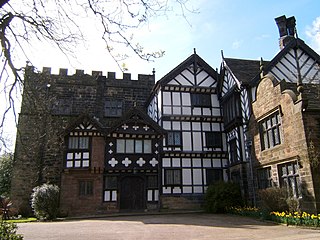
Turton Tower is a manor house in Chapeltown in North Turton, Borough of Blackburn with Darwen, Lancashire, England. It is a scheduled ancient monument and a Grade I listed building.

The Ifield Friends Meeting House is a Friends meeting house in the Ifield neighbourhood of Crawley, a town and borough in West Sussex, England. Built in 1676 and used continuously since then by the Quaker community for worship, it is one of the oldest purpose-built Friends meeting houses in the world. It is classified by English Heritage as a Grade I listed building, a status given to buildings of "exceptional interest" and national importance. An adjoining 15th-century cottage is listed separately at Grade II*, and a mounting block in front of the buildings also has a separate listing at Grade II. Together, these structures represent three of the 100 listed buildings and structures in Crawley.
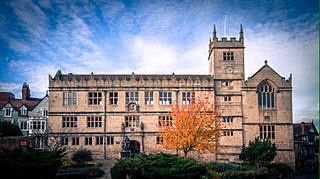
Shrewsbury Library is housed in a Grade I listed building situated on Castle Gates near Shrewsbury Castle. The site was the home of Shrewsbury School from 1550 until 1882. The buildings were handed over to the town in 1882 and a free library and museum were opened by the Corporation of Shrewsbury utilizing the building in 1885. The library was moved temporarily to Raven Meadows in 1976 while the site on Castle Gates underwent extensive restorations. The library was re-opened in 1983 by Princess Margaret.

Leche House is at 17 Watergate Street and Row, Chester, Cheshire, England. It is recorded in the National Heritage List for England as a designated Grade I listed building, and incorporates a section of the Chester Rows. It is considered to be the best preserved medieval town house in Chester.

The Ancient Priors is a medieval timber-framed hall house on the High Street in Crawley, a town and borough in West Sussex, England. It was built in approximately 1450, partly replacing an older structure—although part of this survives behind the present street frontage. It has been expanded, altered and renovated many times since, and fell into such disrepair by the 1930s that demolition was considered. It has since been refurbished and is now a restaurant, although it has been put to various uses during its existence. Secret rooms, whose purpose has never been confirmed for certain, were discovered in the 19th century. English Heritage has listed the building at Grade II* for its architectural and historical importance, and it has been described as Crawley's "most prestigious medieval building" and "the finest timber-framed house between London and Brighton".
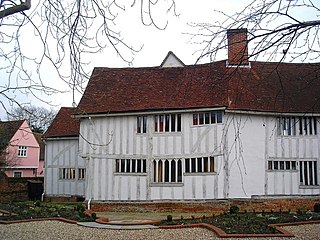
Lavenham Priory is a 13th-century Grade I listed building in Lavenham, Suffolk, England.

The Ancient House is a medieval timber-framed and partly pargeted building located in Clare in Suffolk, England. It is a Grade I listed building.

The Stag Inn is a public house in the Old Town area of Hastings, a port and seaside resort in East Sussex, England. One of many ancient buildings on All Saints Street, the 16th-century timber-framed inn was refronted in the 18th century, but many of its original features remain. The preserved bodies of two smoke-blackened mummified cats have been displayed on a wall since their discovery in the 19th century; witchcraft has been suggested as an explanation for this "grisly sight". The inn, which claims to be Hastings' oldest surviving pub, is operated as a tied house by the Shepherd Neame Brewery, and has been listed at Grade II by English Heritage for its architectural and historical importance.

Caludon Castle is a Scheduled Ancient Monument and Grade I listed building in Coventry, in the West Midlands of England. A second moated site 190 metres (620 ft) to the south is a Scheduled Ancient Monument in its own right. The castle is now a ruin, and all that remains is a large fragment of sandstone wall. What remains of the estate is now an urban park, owned and run by Coventry City Council, but much of it was sold and developed into housing estates in the early 20th century.

Concealed shoes hidden in the fabric of a building have been discovered in many European countries, as well as in other parts of the world, since at least the early modern period. Independent researcher Brian Hoggard has observed that the locations in which these shoes are typically found – in chimneys, under floors, above ceilings, around doors and windows, in the roof – suggest that some may have been concealed as magical charms to protect the occupants of the building against evil influences such as demons, ghosts and witches. Others may have been intended to bestow fertility on a female member of the household, or been an offering to a household deity.

Ipswich Blackfriars was a medieval religious house of Friars-preachers (Dominicans) in the town of Ipswich, Suffolk, England, founded in 1263 by King Henry III and dissolved in 1538. It was the second of the three friaries established in the town, the first being the Greyfriars, a house of Franciscan Friars Minors, and the third the Ipswich Whitefriars of c. 1278–79. The Blackfriars were under the Visitation of Cambridge.
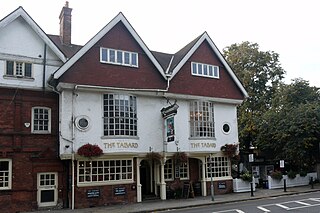
The block of three buildings containing The Tabard public house is a Grade II* listed structure in Chiswick, London. The block, with a row of seven gables in its roof, was designed by Norman Shaw in 1880 as part of the community focus of the Bedford Park garden suburb. The block contains the Bedford Park Stores, once a co-operative, and a house for the manager.
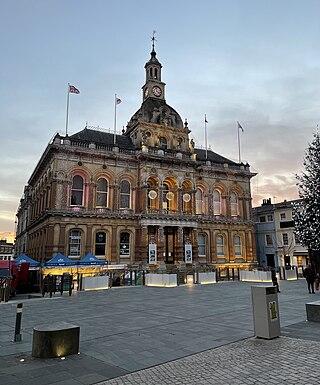
Ipswich Town Hall is a municipal building in Ipswich, in the county of Suffolk, England. It is a Grade II listed building. It is used for meetings of Ipswich Borough Council and also serves as an events venue and art gallery.

The former Salvation Army Hall in Godalming, Surrey, England, now an office building known as Aurum House, has been used by three religious groups since its construction c. 1830. The ancient town in the English county of Surrey has a long and diverse history of Protestant Nonconformity, and three Nonconformst denominations are represented: at first it served Congregationalists, but when they built a larger chapel in the town it passed to the Methodist Church. In the 20th century it was occupied by The Salvation Army, but it closed in 2012 and was redeveloped for commercial use. The building has been listed at Grade II for its architectural and historical importance.

Corn exchanges are distinct buildings which were originally created as a venue for corn merchants to meet and arrange pricing with farmers for the sale of wheat, barley, and other corn crops. The word "corn" in British English denotes all cereal grains, such as wheat and barley. With the repeal of the Corn Laws in 1846, a large number of corn exchanges were built in England, particularly in the corn-growing areas of Eastern England.






















